With increased cyberattacks on organizations of all sizes, digital risk detection is of paramount importance. What is digital risk detection? Digital risk detection is the process of identifying and assessing the threats that organizations face in their digital environments.
It’s the application of a tool or tools to access information on the social, surface, deep, and dark web. It’s seeking out exposures, data breach indicators, threats of violence, or otherwise reputationally damaging content to a brand or an individual’s (typically an executive’s) integrity. Keeping the information funnel succinct with relevant content across so many outlets can be a daunting task, but there are tools available in the marketplace like Media Sonar that aid in filtering the information available into one manageable ecosystem.
In 2023 and beyond, organizations can expect to see the following trends in digital risk detection:
- Increased use of artificial intelligence (AI) and machine learning (ML): AI and ML can be used to analyze large volumes of data to identify patterns and anomalies that may indicate a threat. This can help organizations to detect threats more quickly and accurately than traditional methods.
- Greater focus on insider threats:** Insider threats are threats that come from within an organization, such as from employees, contractors, or suppliers. Insider threats can be particularly difficult to detect, as they may have access to sensitive data and systems. Organizations will need to implement a variety of measures to mitigate insider threats, including digital risk detection tools.
- More sophisticated attacks:** Cybercriminals are constantly developing new and more sophisticated attacks. This means that organizations will need to have a layered approach to digital risk detection, using a variety of tools and techniques to detect and respond to threats.

Here are some tips for organizations to improve their digital risk detection capabilities:
- Implement a variety of detection tools and techniques. This could include AI/ML-based tools, user behavior analytics (UBA), security information and event management (SIEM) systems, and vulnerability scanners.
- Monitor your digital environment continuously. This includes monitoring your networks, systems, applications, and data.
- Have a plan in place to respond to threats. Once a threat is detected, you need to have a plan in place to investigate the threat and take appropriate action.
The Occupational Safety and Health Administration (OSHA) Act of 1970 outlines the duty of care an employer has for keeping a workplace “free of recognized hazards” that could lead to physical harm to a person or persons. This extends to business travel as well. This means an organization must act in a prudent manner to recognize hazards (i.e. be proactive in doing so). Each organization should start with a digital risk assessment to identify its threats and vulnerabilities in order to begin mitigation strategies on how to best tackle the situation presented. Every organization will be unique in its needs due to company culture and risk appetite as well as available resources (capital or otherwise).
While there are a variety of ways to mine information on the web, if you are able to automate searches to collate those into one ecosystem and organize the results in a custom manner germane to your organizational interests how much time would you save your team and efficiency would you create for your operation? Digital risk detection is an essential part of any cybersecurity strategy. By implementing a robust digital risk detection program, organizations can protect themselves from a wide range of threats and reduce the likelihood of a successful cyberattack.
Watch this 2-minute video put together by Media Sonar that discusses’ how their tool functions within this topical matter. Please reach out to the management team at Premier Risk Solutions should you like to discuss your digital risk detection program needs!


